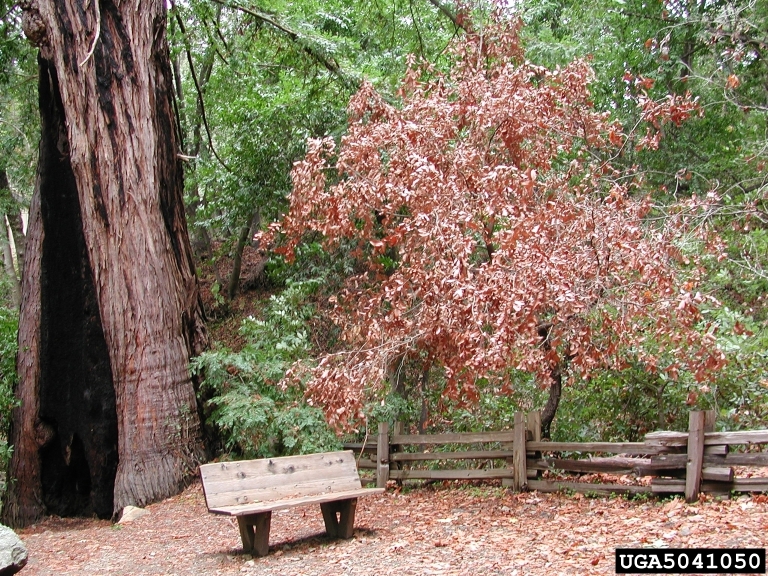Phytophthora ramorum
Sudden Oak Death
Synonym(s):
Class: Phycomycota
Order: Peronosporales
Family: Pythiaceae

Photographer: Joseph O'Brien, USDA Forest Service
Source: bugwood.org
Description
Sudden oak death is caused by the plant pathogen Phytopathora ramorum. This plant pathogen is also known for causing Ramorum blight in host trees. Sudden oak death has caused a large dieback of several oak tree species in forests from Oregon to California. Ramorum blight has the greatest effect on the leaves and twigs of host plants in forests or nurseries.
Symptoms: Symptoms of sudden oak death can appear as more damaging and severe cankers or less fatal foliar symptoms. If canker-like symptoms appear on the woody portion of the tree, side-effects are very severe and usually result in death of the tree. Cankers weaken the host tree's defense making it vulnerable to further attack from other sapwood fungus (Hypoxylon thourasianum) or woodboring beetles (Buprestidae). If leaves or twigs (foliar) are hosts of sudden oak death, symptoms of leaf spotting or twig die back occur, but the infection typically isn't fatal if the foliar portion of the tree is the host.
Wildland diagnostic guide - provided by Plant Management Network
Host(s): Coast live oak, California black oak, Shreve oak, canyon live oak, California bay laurel, Douglas-fir, and coast redwood, and other tanoak tree species.
Ecological Threat: Sudden oak death is capable of killing large amounts of trees in natural forests which poses the greatest threat to surrounding ecosystems that are dependent on the presence of trees for quality of life. With the removal of a large amount of trees wildlife faces a loss of food sources, the frequency of fires is effected, and soil quality changes with increased runoff of top soil.
Biology: The sudden oak death pathogen spreads the most during wet seasons through contaminated plants or soil transferred to home gardens where oak trees are present. The greatest transfer of the pathogen occurs in forested areas with a death toll of over 1 million oak and tanoak trees in the state of California.
History: Sudden Oak death was first discovered in European nurseries in the 1900's where it spread to nearby countries and was later discovered in the United States in 2001 found on trees in a California nursery.The spread of sudden oak death became severe in 2003 when it spread to forests from California north to Washington and British Columbia.
U.S. Habitat: Wet and cool climates provide the ideal habitat for sudden oak death, which allows it to spread rapidly along the fog belt in California and Oregon. Researchers have identified an indicator of the presence of sudden oak death is often queued by the presence of California bay laurel (Umbellularia californica). Nurseries create microclimates that mimic the desired wet and cool climate preferred by sudden oak death allowing it to spread to trees away from the northwest forests of the United States.
Distribution
Native Origin: Europe
U.S. Present: CA, OR, WA
Management
California authorities are currently working to quarantine forested areas and nurseries where sudden oak death pathogens are suspected to be present to prevent further spread. If you live in an area where the pathogen exists, preventitive measures can be taken to oak and tanoak trees by using a phosphonate compound called Agri-Fos, which can be injected directly into the trunk. This is not a cure for sudden oak death, but it can protect trees from contracting the disease, and control further spread if caught in early onset and used properly. Recommended treatment should be applied in the fall or spring with bi-annual treatments of trees that are at the greatest risk for contracting the pathogen.
More information for homeowners - provided by California Oak Mortality Task Force
References
Woodward, Susan L., and Joyce Ann. Quinn. 2011. Sudden Oak Death. Encyclopedia of Invasive Species: From Africanized Honey Bees to Zebra Mussels. Santa Barbara, CA: Greenwood. 25-28. Print.
Internet Sources
www.itis.gov
 Texas Invasive Species Institute
Texas Invasive Species Institute